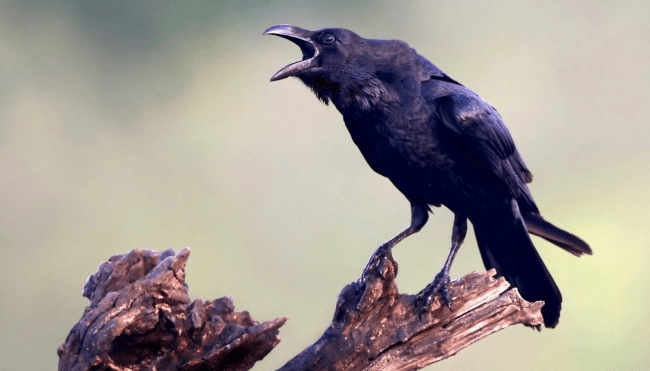County Caithness Can Now Rave about their Raven Flag
Dr. James J. S. Johnson

(BBC photo credit)
Who provides for the raven his food? — when its young ones cry unto God, they wander for lack of meat.
( Job 38:41 )
Having a bird featured upon an official flag is nothing new, so the above flag of Scotland’s County Caithness, which became official (ceremonially celebrated January 26th of A.D.2016) is not a novel concept.
The official unveiling of Scotland’s County Caithness flag, during A.D.2016, was reported by the BBC [q.v., http://www.bbc.com/news/uk-scotland-highlands-islands-42094603 ].

(BBC photo credit)
However, that vexillological event was and is worth noticing, especially to all of us who appreciate ravens — including Mrs. Lee Dusing, and the rest of us who appreciate her world-class bird-blog! (E.g., see one of Lee’s several blogposts, on ravens (and other corvids), at https://leesbird.com/2013/07/03/birds-of-the-bible-raven-iii/ .)
In fact, the first bird to be named (by its kind) within the Holy Bible was a raven. WOW! That’s quite an incomparable honor!
And he [i.e., Noah] sent forth the raven [‘ōrēb], which went forth to and fro, until the waters were dried up from off the earth.
( Genesis 8:7 )

(Wikipedia photo credit)
Likewise, the godly Bible translator and leading Reformer, Dr. Martin Luther, carefully observed and appreciated flocks of ravens (and jackdaws, their corvid cousins), during the adventurous times of the Protestant Reformation’s first generation in Germany. (See “A Diet of Jackdaws and Ravens”, posted at https://leesbird.com/2015/09/16/a-diet-of-jackdaws-and-ravens/ .)
Obviously, ravens are special birds, because God providentially cares for their kind — and tells us so in the Scriptures!
For example, in the Old Testament, within God’s creation sermon to the patriarch Job, Job was questioned about how God takes spare of ravens.
Who provides for the raven his food? — when its young ones cry unto God, they wander for lack of meat.
( Job 38:41 )
Likewise, in the New Testament, the Lord Jesus Christ refers to God’s provision for the physical needs of ravens.
Consider the ravens: for they neither sow nor reap; which neither have storehouse nor barn; and God feeds them; how much more are ye better than the fowls?
( Luke 12:24 )
Ravens are something to rave about!

( ScienceNorway.NO Dennis Jacobsen, Colourbox photo credit )
Ravens are also well known in antiquity, including Viking history, and consequently it is not unusual to see a raven depicted on an ancient banner, such as the flag of the Isle of Man (q.v., at “Northern Raven and Peregrine Falcon: Two Birds Supporting the Manx Coat of Arms”” — [posted at https://leesbird.com/2016/02/12/northern-raven-and-peregrine-falcon-two-birds-supporting-the-manx-coat-of-arms/ ).

(public domain)
In fact, this Christian birdwatching blog has previously blended ornithology (i.e., systematic study of birds) with vexillology (i.e., systematic study of flags). Specifically, years ago (during A.D.2015), this bird-blog features a mini-series captioned “FLAG THAT BIRD!” — about flags of the world that feature a bird.
To review that series, see Part 1 ( https://leesbird.com/2015/04/08/flag-that-bird-part-1/ ),
Part 2 ( https://leesbird.com/2015/04/13/flag-that-bird-part-2/ ),
Part 3 ( https://leesbird.com/2015/04/23/flag-that-bird-part-3/ ),
Part 4 ( https://leesbird.com/2015/04/29/flag-those-birds-part-4/ ), and
Part 5 ( https://leesbird.com/2015/08/25/flag-that-bird-part-5/ ).
So, this blogpost, celebrating the Caithness Raven, now succinctly supplements that ornithological-vexillological series.

(public domain image)
Caithness thus celebrates its Viking heritage, with a flag that contains a Nordic cross, plus the raven of antiquity, well known to Viking literature, along with a galley ship, reminiscent of ocean-faring adventures of northeastern Scotland’s Viking forebears, some who came as visitors, yet many who settled as immigrants, blending in with native Celts, providentially producing future generations of Count Caithness natives (Psalm 102:18).